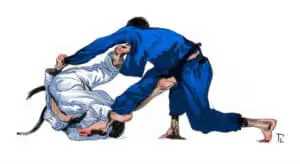
As BJJ continues to explode and expand around the world the rarity and mythical status of black belts is in decline. It seems everyday you hear about another person receiving their black belt and if you train at a big gym you may find 10 to 20 black belts on the mat at each training session.
How Rare Is A BJJ Black Belt?
Even though BJJ black belts are much more common than they were 10 to 15 years ago they are still rare. There are around 50,000 BJJ black belts globally and it estimated around 2% of BJJ athletes are black belts.
Just like climbing and reaching the peak of Mount Everest every year more and more BJJ athletes earn their coveted black belts. With so many people training the sport and gyms now being located everywhere the number of Jiu Jitsu black belts is only going to rise and rise.
While BJJ black belts are more common than just 10 years ago they are still rare and it is an impressive achievement. Currently, it is estimated there are around 50,000 Jiu Jitsu black belts, this is based on assuming that only 10% of the world’s black belts are registered with the International Brazilian Jiu Jitsu Federation.
While 50,000 black belts may sound like a lot you have to factor in that there at least 2 million people training BJJ. This means that black belts only make up around 2% of the BJJ population.
If train in a country where BJJ is only just developing it is very possible that there are no black belts in your entire country. The whole continent of Africa where over 1 billion people live probably has less than 200 black belts. In many countries that have had BJJ for a number of years but the sport is still small there are often only a handful of black belts.
The vast majority of BJJ black belts are concentrated in Brazil and the US. In these countries at major gyms, you can find 30 + black belts on the mat at the same time. A major club in Brazil may have 50 black belt members.
These major clubs in BJJ meccas such as Rio and California are obviously outliers that can really distort the numbers. I think the average successful BJJ gym with around 100 members in a well-established BJJ area should have around 4 to 5 black belt members.
As many BJJ gyms have no black belt members this brings down the average black belt population to around 2% to 2.5% of total practitioners.
We could easily see the number of Jiu Jitsu black belts double or triple within the next 10 years as the sport continues to grow, people have access to more training which is reducing the time it takes to earn the belt and more kids are starting to train at a young age.
Although being a BJJ black belt will never be a common thing it will likely be more akin to being a Judo black belt where every school has 10 + black belts on the mat and while a respectable feat there is a huge range in skill level between different black belts.
BJJ will unlikely ever be a major sport but it can be a widely popular niche sport similar to Judo where there are millions and millions of practitioners all over the world.
Even if BJJ becomes as popular as Judo the fact that to earn your black belt will still take thousands of hours of training will prevent a BJJ black belt from being significantly devalued.
Unfortunately as BJJ has grown a black belt has lost much of its mystique. However, all the benefits of the progression of the sport more than make up for the mythology surrounding black belts being destroyed.
Don’t be fooled though earning a black belt in 2021 is still extremely impressive and due to the increased level of instruction and competition, a fresh black belt from today would most likely toy with a new black belt from 15 years ago. This is just natural as a sport grows and develops. The athletes of today surpass the athletes of yesterday.
Even though old school BJJ athletes like to claim standards were harder back in the day this is more down to the fact that training was limited and many practitioners were lucky to train 3 times a week with a purple belt let alone train 10 times a week with a host of black belts.
Also as more people participate in a sport the level of competition raises and you get more freak athletes who push the sport to new heights. So while there may be more BJJ black belts in 2021 than in 2005 the average black belt today is much more skilled and well rounded.
To see this in action simply go back and watch BJJ comps from the early 2000s and compare them to today, they look like blue and purple belt matches.
